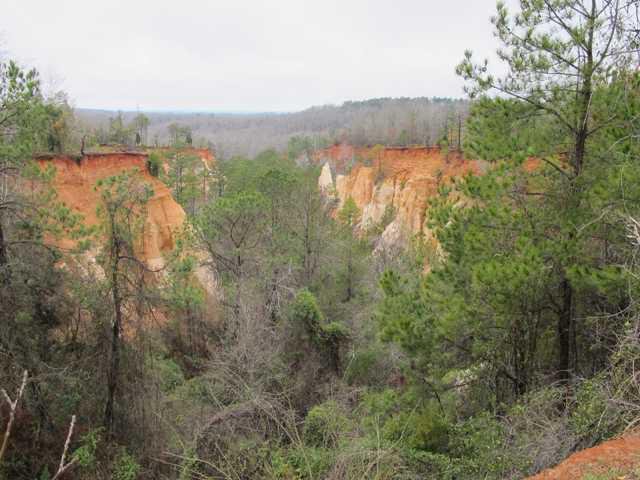About 160 years ago, Providence Canyon was a network of 3- to 5-foot deep drainage ditches created by rainwater runoff from farmers’ fields.
Today, the canyon is a web of 16 canyons that cover nearly 1,100 acres and features gullies as deep as 150 feet.
Considered one of Georgia’s “Seven Wonders,” Providence Canyon — also called “Georgia’s Little Grand Canyon” — now is a state park and a favorite site for hikers and photographers. The park is about 25 miles south of Columbus, roughly a five-hour drive from Hinesville.
The canyon itself is both an object lesson about bad farming practices and a testament to nature’s ability to turn an ecological disaster into something beautiful.
According to New Georgia Encyclopedia, when Georgia’s early settlers moved west and forced out the original inhabitants of the area, the Creek Indians, they cleared the land for farming. Acres and acres of trees were cut down to grow cotton and corn.
Knowledge of soil erosion was non-existent in the 1830s. When the sandy-clay soil was bleached of all its nutrients and failed to produce crops anymore, it was abandoned. More land was cleared for farming, and the erosion cycle continued.
By 1850, 5-foot deep ditches were a nuisance but still not a great concern to local residents. By 1859, the Methodist church that the canyon was named for had to be rebuilt farther away from the ever-growing canyon.
Fences, barns, homes and livestock became prey to the crumbling walls of the canyon during rainstorms.
By the 1940s, area residents heard noises like cannon fire during rain storms as the canyon enlarged itself by swallowing buildings along its rim.
Whatever the canyon claimed remained in the canyon for the most part. About a dozen cars and trucks from the 1950s can be found on one level of the canyon, some with trees growing up through the doors and windows. When it became a state park in 1971, officials determined that removing the old vehicles would pose a greater risk to the environment than leaving their rusty frames where they had been for two decades.
There is a three-mile hike down into the canyon’s rim trail and a seven-mile backcountry hike available for seasoned hikers. The park warns visitors to stay behind the fence, as the fragile canyon edge is subject to crumble, which is evidence that the canyon still is growing.
Those who reach the canyon floor discover it mostly is clay and more resistant to erosion, supporting a variety of trees — pine, sweet gum, weeping willow, tupelo, maple and oak. The rare plumleaf azalea also grows around and inside the canyon. This colorful variety blooms later in the summer, long after other azaleas have stopped blossoming.
Photographers like the spectacular color contrast throughout the canyon, from the pure white sandstone formations to the pink, red, orange and purple clay walls.
Overlooks along the rim offer lots of great picture opportunities, but the best pictures are found along the rim trail down into the canyon floor.
Families interested in visiting the park can find cottage accommodations at nearby Florence Marina State Park or George T. Bagby State Park and Lodge. For more information about Providence Canyon State Park, go to www.gastateparks.org.

